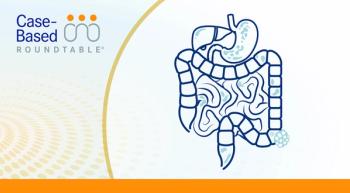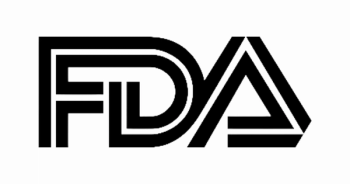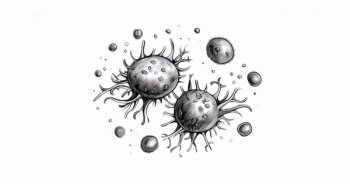
Enfortumab Vedotin Combo Doubles PFS vs Chemo in Urothelial Cancer
Enfortumab vedotin plus pembrolizumab doubled progression-free survival vs chemotherapy in urothelial cancer.
Updated findings from the phase 3 EV-302/KEYNOTE-A39 trial (NCT04223856) showed that first-line enfortumab vedotin-ejfv (Padcev) plus pembrolizumab (Keytruda) continued to outperform chemotherapy, providing sustained progression-free and overall survival (OS) benefits, along with durable responses in patients with previously untreated locally advanced or metastatic urothelial carcinoma.1
Findings from a rapid oral session at the 2025 Genitourinary Cancers Symposium showed that, at a median follow-up of 29.1 months (95% CI, 28.5-29.9), the combination therapy (n = 442) achieved a median progression-free survival of 12.5 months (95% CI, 10.4-16.6) compared with 6.3 months (95% CI, 6.2-6.5) with chemotherapy (n = 444; HR, 0.48; 95% CI, 0.41-0.57; 2-sided P < .00001). The 12- and 24-month progression-free survival rates were 51.4% and 37.1% with enfortumab vedotin plus pembrolizumab, versus 21.7% and 12.6% with chemotherapy.
The doublet also resulted in a median OS of 33.8 months (95% CI, 26.1-39.3) vs 15.9 months (95% CI, 13.6-18.3) with chemotherapy (HR, 0.51; 95% CI, 0.43-0.61; 2-sided P < .00001). The 12-month OS rates in the respective arms were 77.7% and 61.1%; at 24 months, these rates were 60.1% and 35.4%.
“After 2.5 years of median follow-up, we continue to show a compelling benefit for enfortumab vedotin and pembrolizumab over chemotherapy,” Thomas B. Powles, MBBS, MRCP, MD, said in a presentation of the data. “Median OS is 34 months, [which] I think is unprecedented compared with what we saw before. The frequency of treatment-related adverse effects [TRAEs] is consistent with what we saw previously…These data reinforce enfortumab vedotin and pembrolizumab as the new standard of care in frontline urothelial cancer.”
Powles is a professor of genitourinary oncology, lead for Solid Tumor Research, and director of Barts Cancer Centre at St. Bartholomew’s Hospital, Queen Mary University of London, in London, United Kingdom.
Evaluating EV-302: Population, Treatment, End Points
Patients with previously untreated locally advanced or metastatic urothelial carcinoma who were eligible for platinum chemotherapy, enfortumab vedotin, and pembrolizumab were enrolled to EV-302. They had a glomerular filtration rate (GFR) of at least 30 mL/min and an ECOG performance status no higher than 2. Those with a status of 2 also needed to have hemoglobin of at least 10 g/dL and GFR of at least 50 mL/min but may not have NYHA class III heart failure. They could not have had prior exposure to a PD-1 or PD-L1 inhibitor.
Participants were randomized 1:1 to receive enfortumab vedotin at 1.25 mg/kg on days 1 and 8 and pembrolizumab at 200 mg on day 1 for 3 cycles vs chemotherapy in form of cisplatin or carboplatin plus gemcitabine for a maximum of 6 cycles. Treatment continued until progressive disease by blinded independent central review (BICR), clinical progression, intolerable toxicity, or the maximum cycles had been completed.
They were stratified by cisplatin eligibility (ineligible vs eligible), PD-L1 expression (high: combined positive score (CPS) of ≥10 vs low: CPS of <10), and liver metastases (present or absent).
The dual primary end points of the study were PFS by BICR and OS. Key secondary end points comprised objective response rate (ORR) by RECIST v1.1 criteria and BICR, investigator-assessed ORR, duration of response (DOR), and safety.
The Road That Led to the Current Analysis
Data from the primary analysis showed that treatment with the doublet led to a median PFS of 12.5 months (95% CI, 10.4-16.6), compared with platinum-based chemotherapy, at 6.3 months (95% CI, 6.2-6.5); the hazard ratio (HR) was 0.45.2 Moreover, the median OS with enfortumab vedotin plus pembrolizumab was 31.5 months (95% CI, 25.4-not evaluable [NE]) vs 16.1 months (95% CI, 13.9-18.3) with chemotherapy (HR, 0.47).
These data supported the FDA’s decision to convert the accelerated
Diving Into the Updated Data
The data cutoff date for the current analysis of the study was August 8, 2024. With 29.1 months of median follow-up, 12% of patients on the doublet arm were still receiving treatment vs no patients on the chemotherapy arm. Moreover, 49% of those in the investigative arm vs 30% of those on the control arm remained on study.
Notably, the PFS benefit derived with enfortumab vedotin plus pembrolizumab over chemotherapy proved to be consistent across prespecified subgroups, irrespective of primary disease site of origin (upper tract disease: HR, 0.542; lower tract disease: HR, 0.462), liver metastases (present: HR, 0.548; absent: HR, 0.458), PD-L1 expression (low: HR, 0.517; high: HR, 0.459, platinum eligibility (eligible: HR, 0.518; ineligible: HR, 0.455), presence of metastatic disease (visceral: HR, 0.477; lymph node only: HR, 0.473), and renal function (normal: HR, 0.520; mild: HR, 0.477; moderate/severe: HR, 0.493).
The same was true for OS benefit. “Again, the benefit is seen across these subgroups of patients; it doesn’t matter about platinum eligibility [eligible: HR, 0.541; ineligible: HR, 0.498], liver metastases [present: HR, 0.556; absent: HR, 0.496], PD-L1 expression [low: HR, 0.472; high: HR, 0.550], sites of metastatic disease [visceral: HR, 0.505; lymph node only: HR, 0.512], upper tract disease [HR, 0.538; lower tract: HR, 0.504], or performance status [0: HR, 0.394; 1 to 2: HR, 0.621],” Powles noted.
Notably, the survival benefit achieved with the doublet was consistent with the overall population irrespective of cisplatin eligibility. In cisplatin-eligible patients, enfortumab vedotin plus pembrolizumab (n = 244) led to a median OS of 36.7 months (95% CI, 31.5-NE) vs 18.7 months (95% CI, 16.6-22.1) with chemotherapy (n = 234; stratified HR, 0.54; 95% CI, 0.42-0.70). In those not eligible for cisplatin, the median OS with the doublet (n = 198) and chemotherapy (n = 210) was 25.6 months (95% CI, 22.7-36.1) and 12.7 months (95% CI, 11.0-14.7), respectively (HR, 0.50; 95% CI, 0.39-0.64).
The confirmed ORR in the investigative arm was 67.5% (95% CI, 62.9%-71.9%) vs 44.2% (95% CI, 39.5%-49.0%) with chemotherapy (2-sided P < .00001). The median DOR with the doublet was 23.3 months (95% CI, 17.8-NE) vs 7.0 months (95% CI, 6.2-9.0) with chemotherapy. The 12-month DOR rates with the doublet and chemotherapy were 67.5% and 35.1%, respectively; the 24-month rates were 49.4% and 24.0%.
“We were able to start looking at things like DOR because of the extended follow-up, and here, we show that among the responders, the probability of maintained response at 2 years was 50%,” Powles said. Remember, it’s important to recognize that about 70% of these patients are responding, and they maintain their response at 2 years. In my opinion, I think that’s transformative. We also showed that 30% of patients had complete response [CR], which, again, was unprecedented in this setting.”
When taking a closer look at the duration of confirmed CR (cCR), they found that the probability of maintained CR at 24 months was 74.3% with enfortumab vedotin plus pembrolizumab vs 43.2% with chemotherapy. In patients with cCR, the HR for PFS was 0.36 (95% CI, 0.21-0.61), with estimated 24-month PFS rates of 78.2% for the doublet and 53.7% for chemotherapy. The HR for OS was 0.37 (95% CI, 0.17-0.80) in this subset, with estimated 24-month OS rates of 95.4% and 85.8% in the respective arms.
Powles concluded by noting that with an additional 1 year of follow-up, the toxicity profile of the doublet remained consistent with prior reports. No new safety signals were observed, and the frequency and grade of TRAEs were consistent with what was shared in the primary analysis of the trial.
Disclosures: Powles disclosed receipt of research grants (institution) from Astellas Pharma, AstraZeneca, Bristol Myers Squibb, Eisai, EMD Serono Inc., Exelixis, F. Hoffman-La Roche, Gilead Sciences Inc., Ipsen Biopharm Limited, Johnson & Johnson Health Care Systems Inc., Merck, MSD, Novartis, Pfizer, and Seagen. Research grants (individual) were received by Mashup Communications. Powles serves in a consultancy capacity or received honoraria from Astellas Pharma, AstraZeneca, Bristol Myers Squibb, Eisai, EMD Serono Inc., Exelixis, F. Hoffman-La Roche, Gilead Sciences Inc., Incyte Corporation, Ipsen Biopharm Limited, Johnson & Johnson Health Care Systems Inc., Mashup Communications, Merck, MSD, Novartis, Pfizer, and Seagen. Travel and accommodation expenses were provided by AstraZeneca, F. Hoffman-La Roche, Gilead Sciences Inc., Ipsen Biopharm Limited, Mashup Communications, Merck, MSD, and Pfizer.
References
Powles TB, Van der Heijden MS, Loriot Y, et al. EV-302: Updated analysis from the phase 3 global study of enfortumab vedotin in combination with pembrolizumab (EV+P) vs chemotherapy (chemo) in previously untreated locally advanced or metastatic urothelial carcinoma (la/mUC). J Clin Oncol. 2025;43(suppl 5):664. doi:10.1200/JCO.2025.43.5_suppl.658
Powles T, Valderrama BP, Gupta S, et al. Enfortumab vedotin and pembrolizumab in untreated advanced urothelial cancer. N Engl J Med. 2024;390(10):875-888. doi:10.1056/NEJMoa2312117
FDA approves enfortumab vedotin-ejfv with pembrolizumab for locally advanced or metastatic urothelial cancer. FDA. December 15, 2023. Accessed February 15, 2025. https://www.fda.gov/drugs/resources-information-approved-drugs/fda-approves-enfortumab-vedotin-ejfv-pembrolizumab-locally-advanced-or-metastatic-urothelial-cancer








































